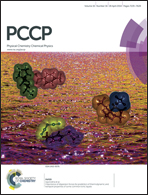Heat treatment effect on the electronic and magnetic structures of nanographene sheets investigated through electron spectroscopy and conductance measurements
Abstract
The heat treatment effect on the electronic and magnetic structures of a disordered network of nanographene sheets has been investigated by in situ measurements of X-ray photoemission spectroscopy, near-edge X-ray absorption fine structure (NEXAFS), and electrical conductance, together with temperature-programmed desorption measurements. Oxygen-containing functional groups bonded to nanographene edges in the pristine sample are almost completely decomposed under heat treatment up to 1300–1500 K, resulting in the formation of edges primarily terminated by hydrogen. The removal of the oxygen-containing groups enhances the conductance owing to the decrease in the electron transport barriers between nanographene sheets. Heat treatment above 1500 K removes also the hydrogen atoms from the edges, promoting the successive fusion of nanographene sheets at the expense of edges. The decrease in the π* peak width in NEXAFS indicates the progress of the fusion reaction, that is, the extension of the π-conjugation, which agrees with the increase in the orbital susceptibility previously reported. The fusion leads to the formation of local π/sp2 bridges between nanographene sheets and brings about an insulator-to-metal transition at 1500–1600 K, at which the bridge network becomes infinite. As for the magnetism, the intensity of the edge state peak in NEXAFS, which corresponds to the number of the spin-polarized edge states, decreases above 1500 K, though the effective edge-state spin density per edge state starts decreasing at approximately 200 K lower than the temperature of the edge state peak change. This disagreement indicates the development of antiferromagnetic short range ordering as a precursor of a spin glass state near the insulator–metal transition, at which the random network of inter-nanographene-sheet exchange interactions strengthened with the formation of the π/sp2 bridges becomes infinite.


 Please wait while we load your content...
Please wait while we load your content...